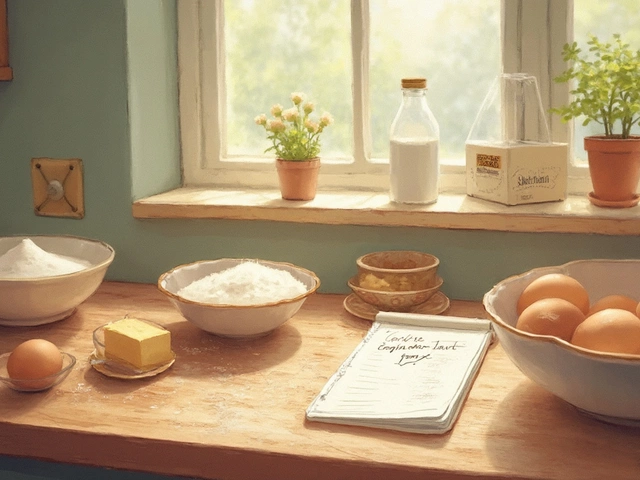When you think of a dessert that perfectly encapsulates the flavors and flair of Italy, it’s tough to look past the creamy, coffee-rich masterpiece that is tiramisu. This dessert isn't just popular in Italy; it's beloved worldwide, and there's good reason for it. Besides its delicious taste, it tells a story of Italian tradition and ingenuity.
First off, let’s talk about its origins. Legend has it that this irresistible dish started in the Veneto region, home of Venice, in the late 1960s. Though its history isn't as ancient as some Italian classics, tiramisu quickly made a name for itself with its distinct layers and bold flavors.
Making tiramisu at home might sound intimidating, but with the right ingredients and a bit of patience, it’s entirely doable. Here are a few essentials: carefully chosen ladyfinger biscuits, freshly brewed espresso, rich mascarpone cheese, eggs, sugar, and cocoa powder. Each plays a crucial role in achieving that perfect balance of bittersweet and creamy goodness.
- The Origins of Tiramisu
- Essential Ingredients for Authenticity
- Step-by-Step Creation
- Regional Variations
- Tips for the Perfect Tiramisu
- Fun Facts about Tiramisu
The Origins of Tiramisu
Diving into the history of tiramisu is like exploring a delicious mystery. While this dessert feels like a timeless classic, it actually emerged fairly recently, mostly popping up in its recognizable form in the late 20th century. Its roots trace back to the Veneto region, specifically in the city of Treviso.
Some say it was first concocted at a restaurant called Le Beccherie in the 1960s, while others argue it might have even earlier origins. There’s a bit of friendly debate over who can claim the bragging rights, but most agree that Le Beccherie played a pivotal role in popularizing this creamy delight.
The name itself, 'tiramisu,' is Italian for 'pick me up' or 'cheer me up.' Why? Probably because of its rich mix of coffee and cocoa, paired with silky mascarpone, makes for a comforting and energizing treat.
Here’s an interesting tidbit: Many Venetian families had their own spin on the recipe, often passed down from one generation to the next. Despite its relatively short history, the dessert quickly cemented itself as not only a staple in Italian cuisine but also as an international favorite. This rapid rise in global popularity highlights its universal appeal.
Essential Ingredients for Authenticity
Creating an authentic Tiramisu isn't just about mixing things together; it’s about using the right ingredients to capture that classic Italian essence. Each component has a role in making sure your dessert isn't just delicious but also true to its roots.
Ladyfinger Biscuits
First up, the unsung heroes of any legit Tiramisu—the ladyfingers, or 'savoiardi' as they're called in Italy. You want them firm and slightly dry, so they soak up just the right amount of espresso without going mushy. Skip the spongy stuff; it won’t give you the texture you’re aiming for.
Authentic Espresso
Speaking of espresso, this isn’t the time to cut corners. Brew up a strong batch—preferably using Italian coffee beans. Trust me, that rich coffee flavor is what gives your Italian dessert its characteristic kick.
Mascarpone Cheese
Nope, you can’t just swap in cream cheese here. Mascarpone is essential for that smooth, creamy texture. It’s a soft Italian cheese that adds a lush creaminess to the dessert without overpowering the other flavors.
Eggs and Sugar
You'll want fresh eggs, since you're using them raw, coupled with sugar to create a rich custard base. Beat them until they're pale and fluffy for the best texture. A little effort goes a long way.
Cocoa Powder
Finish it all off with a dusting of quality cocoa powder on the top. It provides a slight bitterness that balances the dessert’s sweetness.
"The secret to a memorable Tiramisu lies in fresh ingredients and attention to layering," says Giorgio Locatelli, a renowned Italian chef.
| Item | Recommended Brand |
|---|---|
| Ladyfingers | Savoia |
| Espresso Beans | Lavazza |
| Mascarpone | Galbani |
Get these ingredients right and half the battle is won. Now you’re well on your way to serving up a crowd-pleasing dessert that screams authenticity.
Step-by-Step Creation
Crafting a perfect Tiramisu involves a few essential steps, but with a little love and attention, you can create a dessert that makes everyone swoon. Before diving into the specifics, make sure you've gathered your ingredients—this will save you the hassle of pausing midway to grab something you're missing.
Gathering Your Ingredients
You'll need the following to make an authentic tiramisu:
- 300g of ladyfinger biscuits
- 500g of fresh mascarpone cheese
- 4 large eggs, separated
- 100g of granulated sugar
- 200ml of freshly brewed espresso (cooled)
- Unsweetened cocoa powder
- Optional: a splash of coffee liqueur for deeper flavor
Preparation Process
- Blend egg yolks and sugar: Start by beating the egg yolks and sugar together until the mixture is pale and creamy. This step is crucial for the thick and rich texture of the mascarpone cream.
- Add mascarpone: Gradually fold the mascarpone cheese into the yolk mixture. Ensure there are no lumps for a smooth finish.
- Beat egg whites: In a separate bowl, whisk the egg whites until stiff peaks form and gently incorporate them into the mascarpone mix. This gives your tiramisu a light and airy texture.
- Dip ladyfingers: Quickly immerse ladyfingers in the espresso (and liqueur if using). Be careful not to soak them so they don't become soggy.
- Layer the dessert: In your chosen dish, start with a layer of dipped ladyfingers, followed by a generous coat of mascarpone cream. Repeat the process until all ingredients are used, finishing with a mascarpone layer.
- Dust with cocoa: Dust the top layer of cream with cocoa powder for that classic tiramisu look.
- Chill: Let your tiramisu chill in the fridge for at least 4 hours (or overnight) to set properly.
According to Italian chef Giorgio Locatelli, "The secret of making a good tiramisu lies in the quality of the mascarpone and coffee used. These two ingredients can make or break your dessert."
Final Touches
Before serving, you might want to sprinkle extra cocoa or garnish with chocolate shavings for a bit of flair. Remember, patience is key. Letting the flavors meld in the fridge enhances the overall taste, so resist the urge to dig in immediately!
Regional Variations
Italy is known for its rich culinary diversity, and tiramisu is no exception to this rule. While the classic version came from the Veneto region, other areas of Italy have put their own unique spin on this beloved dessert, creating their own distinct takes that suit local tastes and ingredients.
An Umbrian Twist
In Umbria, things take a fruitier turn. This region often incorporates seasonal fruits like strawberries or raspberries, adding a fresh burst of flavor and a colorful contrast to the otherwise monochromatic layers of the dessert. It's not uncommon to see a hint of limoncello, Italy’s beloved lemon liqueur, making its way into the mix, acting as a zesty surprise in each bite.The Sicilian Spin
Down in Sicily, where the sun shines brighter, tiramisu might adopt ingredients reflecting the island’s bountiful produce. Pistachios, known for their vibrant green hue and nutty flavor, often make an appearance, either sprinkled on top or incorporated within the cream. Sometimes, almonds take the stage, offering a subtle sweetness that complements the bold elements of coffee and cocoa.Calabria’s Nutty Influence
Over in Calabria, walnuts are king. This region loves to incorporate local walnut liqueur, giving tiramisu an even deeper, earthier taste. The liqueur blends beautifully with coffee-soaked biscuits, enhancing the dessert’s overall richness.These regional variations offer exciting ways to experience a famous Italian dish like tiramisu differently, highlighting local ingredients and culinary creativity. If you're traveling through Italy or trying Italian recipes at home, experimenting with these variations could lead to your new favorite dessert.
Tips for the Perfect Tiramisu
Getting that perfect Tiramisu requires a bit of technique, but don't worry, I've got some tips to help you out. These tips can elevate your dessert from good to "can't stop eating" level.
1. Choose Quality Ingredients
Start with high-quality ingredients. Good mascarpone cheese is a must—its creamy texture and rich flavor make a world of difference. For the coffee, use freshly brewed, strong espresso for the deepest flavor profile. And don’t skimp on the cocoa powder; a high-quality unsweetened cocoa adds the perfect finishing touch.
2. Properly Layer Your Tiramisu
Layering is crucial. Ensure your ladyfingers are evenly soaked. They need to be just moist, not soggy. Quickly dip each side into the chilled espresso. Then, arrange them snugly to create a solid base.
3. Patience is Key
After all layers are assembled, let your tiramisu rest in the fridge. Ideally, chill it for at least 6 hours, but overnight is even better. This time allows the flavors to blend together beautifully.
4. Add Your Personal Touch
Personalize your tiramisu by experimenting with flavors. Some like to add a dash of rum or amaretto to the coffee mixture for an extra kick.
5. Presentation Matters
Serve your perfect tiramisu with a light dusting of cocoa on top just before placing it on the table. If you’re feeling fancy, a few chocolate shavings or a whole coffee bean can make it visually appealing.
Each of these steps contributes to making your tiramisu a standout dessert. And remember, practice makes perfect, so don't hesitate to create this Italian dessert multiple times, tweaking and perfecting it to suit your taste.
Fun Facts about Tiramisu
Tiramisu isn't just a treat for your taste buds; it's full of surprises and stories that add more flavor to each bite. One fun fact? Tiramisu's name literally means 'pick me up', probably because of the double whammy of caffeine from the espresso and the sugar rush.
Did you know that this Italian dessert gained massive popularity in the 1980s? It wasn't an instant sensation when it first appeared. However, it got its big break when travelers began raving about it, and chefs around the world tried adding it to their menus.
Variations Across the Globe
Though the classic version is iconic, variations abound. In some places, you'll find people adding everything from a touch of liquor, like Marsala wine or rum, to fruit layers such as berries. This makes tiramisu a versatile dessert that can adapt to different palates and dietary needs.
Tiramisu in Numbers
Here's a quick look at some engaging numbers associated with this dessert:
| Fact | Details |
|---|---|
| Calories in a typical serving | About 500 - 600 kcal |
| Year of creation | Approximately 1960s |
| Number of ingredients | Usually 6-7 in the traditional recipe |
If you ever find yourself in Italy, visiting Treviso in the Veneto region is a must for tiramisu lovers; it's considered the birthplace of this beloved dessert. You might even find locals fiercely debating which variation is the most 'authentic'.
So, while the creamy layers and coffee flavor make tiramisu a beloved indulgence, knowing its history and quirks adds another layer to savor.




